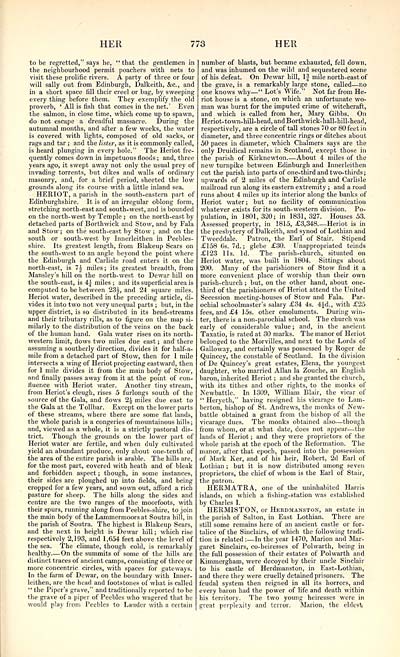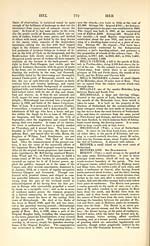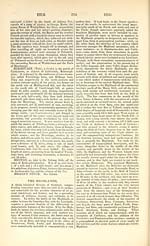Topographical, statistical, and historical gazetteer of Scotland > Volume 1
(873) Page 773
Download files
Complete book:
Individual page:
Thumbnail gallery: Grid view | List view

HER
773
HER
to be regretted," says he, "that the gentlemen in
the neighbourhood permit poachers with nets to
visit these prolific rivers. A party of three or four
will sally out from Edinburgh, Dalkeith, &c, and
in a short space fill their creel or bag, by sweeping
every thing before them. They exemplify the old
proverb, ' All is fish that comes in the net. ' Even
the salmon, in close time, which come up to spawn,
do not escape a dreadful massacre. During the
autumnal months, and after a few weeks, the water
is covered with lights, composed of old sacks, or
rags and tar ; and the lister, as it is commonly called,
is heard plunging in every hole." The Heriot fre-
quently comes down in impetuous floods ; and, three
years ago, it swept away not only the usual prey of
invading torrents, but dikes and walls of ordinary
masonry, and, for a brief period, sheeted the low
grounds along its course with a little inland sea.
HERIOT, a parish in the south-eastern part of
Edinburghshire. It is of an irregular oblong form,
stretching north-east and south-west, and is bounded
on the north-west by Temple ; on the north-east by
detached parts of Borthwick and Stow, and by Fala
and Stow ; on the south-east by Stow ; and on the
south or south-west by Innerleithen in Peebles-
shire. Its greatest length, from Blakeup Scars on
the south-west to an angle beyond the point where
the Edinburgh and Carlisle road enters it on the
north-east, is 7| miles ; its greatest breadth, from
Mansley's hill on the north-west to Dewar hill on
the south-east, is 4J miles ; and its superficial area is
computed to be between 23|, and 24 square miles.
Heriot water, described in the preceding article, di-
vides it into two not very unequal parts ; but, in the
upper district, is so distributed in its head-streams
and their tributary rills, as to figure on the map si-
milarly to the distribution of the veins on the back
of the human hand. Gala water rises on its north-
western limit, flows two miles due east ; and there
assuming a southerly direction, divides it for half-a-
mile from a detached part of Stow, then for 1 mile
intersects a wing of Heriot projecting eastward, then
for 1 mile divides it from the main body of Stow,
and finally passes away from it at the point of con-
fluence with Heriot water. Another tiny stream,
from Heriot 's cleugh, rises 5 furlongs south of the
source of the Gala, and flows 2| miles due east to
the Gala at the Tollbar. Except on the lower parts
of these streams, where there are some flat lands,
the whole parish is a congeries of mountainous hills ;
and, viewed as a whole, it is a strictly pastoral dis-
trict. Though the grounds on the lower part of
Heriot water are fertile, and when duly cultivated
yield an abundant produce, only about one-tenth of
the area of the entire parish is arable. The hills are,
for the most part, covered with heath and of bleak
and forbidden aspect ; though, in some instances,
their sides are ploughed up into fields, and being
cropped for a few years, and sown out, afford a rich
pasture for sheep. The hills along the sides and
centre are the two ranges of the moorfoots, with
their spurs, running along from Peebles-shire, to join
the main body of the Lammermoors at Soutra hill, in
the parish of Soutra. The highest is Blakeup Scars,
and the next in height is Dewar hill ; which rise
respectively 2,193, and 1,654 feet above the level of
the sea. The climate, though cold, is remarkably
healthy — On the summits of some of the hills are
distinct traces of ancient camps, consisting of three or
more concentric circles, with spaces for gateways.
In the farm of Dewar, on the boundary with Inner-
leithen, are the head and footstones of what is called
"the Piper's grave," and traditionally reported to be
the grave of a piper of Peebles who wagered that he
would play from Peebles to Lauder with a certain
number of blasts, but became exhausted, fell down,
and was inhumed on the wild and sequestered scene
of his defeat. On Dewar hill, 1 J mile north-east of
the grave, is a remarkably large stone, called — no
one knows why — " Lot's Wife." Not far from He-
riot house is a stone, on which an unfortunate wo-
man was burnt for the imputed crime of witchcraft,
and which is called from her, Mary Gibbs. On
Heriot-town-hill-head, and Borthwick-hall-hill-head,
respectively, are a circle of tall stones 70 or 80 feet in
diameter, and three concentric rings or ditches about
50 paces in diameter, which Chalmers says are the
only Druidical remains in Scotland, except those in
the parish of Kirknewton About 4 miles of the
new turnpike between Edinburgh and Innerleithen
cut the parish into parts of one-third and two-thirds;
upwards of 2 miles of the Edinburgh and Carlisle
mailroad run along its eastern extremity ; and a road
runs about 4 miles up its interior along the banks of
Heriot water; but no facility of communication
whatever exists for its south-western division. Po-
pulation, in 1801, 320; in 1831, 327. Houses 53.
Assessed property, in 1815, £3,348 Heriot is in
the presbytery of Dalkeith, and synod of Lothian and
Tweeddale. Patron, the Earl of Stair. Stipend
£158 6s. 7d. ; glebe £30. Unappropriated teinds
£123 lis. Id. The parish-church, situated on
Heriot water, was built in 1804. Sittings about
200. Many of the parishioners of Stow find it a
more convenient place of worship than their own
parish-church ; but, on the other hand, about one-
third of the parishioners of Heriot attend the United
Secession meeting-houses of Stow and Fala. Par-
ochial schoolmaster's salary £34 4s. 4Jd., with £25
fees, and £4 15s. other emoluments. During win-
ter, there is a non-parochial school. The church was
early of considerable value ; and, in the ancient
Taxatio, is rated at 30 marks. The manor of Heriot
belonged to the Morvilles, and next to the Lords of
Galloway, and certainly was possessed by Roger de
Quincey, the constable of Scotland. In the division
of De Quincey 's great estates, Elena, the youngest
daughter, who married Allan la Zouche, an English
baron, inherited Heriot ; and she granted the church,
with its tithes and other rights, to the monks of
Newbattle. In 1309, William Blair, the vicar of
" Heryeth," having resigned his vicarage to Lam-
berton, bishop of St. Andrews, the monks of New-
battle obtained a grant from the bishop of all the
vicarage dues. The monks obtained also — though
from whom, or at what date, does not appear. — the
lands of Heriot ; and they were proprietors of the
whole parish at the epoch of the Reformation. The
manor, after that epoch, passed into the possession
of Mark Ker, and of his heir, Robert, 2d Earl of
Lothian ; but it is now distributed among seven
proprietors, the chief of whom is the Earl of Stair,
the patron.
HERMATRA, one of the uninhabited Harris
islands, on which a fishing-station was established
by Charles I.
HERMISTON, or Herdmanston, an estate in
the parish of Salton, in East Lothian. There are
still some remains here of an ancient castle or for-
talice of the Sinclairs, of which the following tradi-
tion is related : — In the year 1470, Marion and Mar-
garet Sinclairs, co-heiresses of Polwarth, being in
the full possession of their estates of Polwarth and
Kimmergham, were decoyed by their uncle Sinclair
to his castle of Herdmanston, in East-Lothian,
and there they were cruelly detained prisoners. The
feudal system then reigned in all its horrors, and
every baron had the power of life and death within
his territory. The two young heiresses were in
great perplexity and terror. Marion, the eldest
773
HER
to be regretted," says he, "that the gentlemen in
the neighbourhood permit poachers with nets to
visit these prolific rivers. A party of three or four
will sally out from Edinburgh, Dalkeith, &c, and
in a short space fill their creel or bag, by sweeping
every thing before them. They exemplify the old
proverb, ' All is fish that comes in the net. ' Even
the salmon, in close time, which come up to spawn,
do not escape a dreadful massacre. During the
autumnal months, and after a few weeks, the water
is covered with lights, composed of old sacks, or
rags and tar ; and the lister, as it is commonly called,
is heard plunging in every hole." The Heriot fre-
quently comes down in impetuous floods ; and, three
years ago, it swept away not only the usual prey of
invading torrents, but dikes and walls of ordinary
masonry, and, for a brief period, sheeted the low
grounds along its course with a little inland sea.
HERIOT, a parish in the south-eastern part of
Edinburghshire. It is of an irregular oblong form,
stretching north-east and south-west, and is bounded
on the north-west by Temple ; on the north-east by
detached parts of Borthwick and Stow, and by Fala
and Stow ; on the south-east by Stow ; and on the
south or south-west by Innerleithen in Peebles-
shire. Its greatest length, from Blakeup Scars on
the south-west to an angle beyond the point where
the Edinburgh and Carlisle road enters it on the
north-east, is 7| miles ; its greatest breadth, from
Mansley's hill on the north-west to Dewar hill on
the south-east, is 4J miles ; and its superficial area is
computed to be between 23|, and 24 square miles.
Heriot water, described in the preceding article, di-
vides it into two not very unequal parts ; but, in the
upper district, is so distributed in its head-streams
and their tributary rills, as to figure on the map si-
milarly to the distribution of the veins on the back
of the human hand. Gala water rises on its north-
western limit, flows two miles due east ; and there
assuming a southerly direction, divides it for half-a-
mile from a detached part of Stow, then for 1 mile
intersects a wing of Heriot projecting eastward, then
for 1 mile divides it from the main body of Stow,
and finally passes away from it at the point of con-
fluence with Heriot water. Another tiny stream,
from Heriot 's cleugh, rises 5 furlongs south of the
source of the Gala, and flows 2| miles due east to
the Gala at the Tollbar. Except on the lower parts
of these streams, where there are some flat lands,
the whole parish is a congeries of mountainous hills ;
and, viewed as a whole, it is a strictly pastoral dis-
trict. Though the grounds on the lower part of
Heriot water are fertile, and when duly cultivated
yield an abundant produce, only about one-tenth of
the area of the entire parish is arable. The hills are,
for the most part, covered with heath and of bleak
and forbidden aspect ; though, in some instances,
their sides are ploughed up into fields, and being
cropped for a few years, and sown out, afford a rich
pasture for sheep. The hills along the sides and
centre are the two ranges of the moorfoots, with
their spurs, running along from Peebles-shire, to join
the main body of the Lammermoors at Soutra hill, in
the parish of Soutra. The highest is Blakeup Scars,
and the next in height is Dewar hill ; which rise
respectively 2,193, and 1,654 feet above the level of
the sea. The climate, though cold, is remarkably
healthy — On the summits of some of the hills are
distinct traces of ancient camps, consisting of three or
more concentric circles, with spaces for gateways.
In the farm of Dewar, on the boundary with Inner-
leithen, are the head and footstones of what is called
"the Piper's grave," and traditionally reported to be
the grave of a piper of Peebles who wagered that he
would play from Peebles to Lauder with a certain
number of blasts, but became exhausted, fell down,
and was inhumed on the wild and sequestered scene
of his defeat. On Dewar hill, 1 J mile north-east of
the grave, is a remarkably large stone, called — no
one knows why — " Lot's Wife." Not far from He-
riot house is a stone, on which an unfortunate wo-
man was burnt for the imputed crime of witchcraft,
and which is called from her, Mary Gibbs. On
Heriot-town-hill-head, and Borthwick-hall-hill-head,
respectively, are a circle of tall stones 70 or 80 feet in
diameter, and three concentric rings or ditches about
50 paces in diameter, which Chalmers says are the
only Druidical remains in Scotland, except those in
the parish of Kirknewton About 4 miles of the
new turnpike between Edinburgh and Innerleithen
cut the parish into parts of one-third and two-thirds;
upwards of 2 miles of the Edinburgh and Carlisle
mailroad run along its eastern extremity ; and a road
runs about 4 miles up its interior along the banks of
Heriot water; but no facility of communication
whatever exists for its south-western division. Po-
pulation, in 1801, 320; in 1831, 327. Houses 53.
Assessed property, in 1815, £3,348 Heriot is in
the presbytery of Dalkeith, and synod of Lothian and
Tweeddale. Patron, the Earl of Stair. Stipend
£158 6s. 7d. ; glebe £30. Unappropriated teinds
£123 lis. Id. The parish-church, situated on
Heriot water, was built in 1804. Sittings about
200. Many of the parishioners of Stow find it a
more convenient place of worship than their own
parish-church ; but, on the other hand, about one-
third of the parishioners of Heriot attend the United
Secession meeting-houses of Stow and Fala. Par-
ochial schoolmaster's salary £34 4s. 4Jd., with £25
fees, and £4 15s. other emoluments. During win-
ter, there is a non-parochial school. The church was
early of considerable value ; and, in the ancient
Taxatio, is rated at 30 marks. The manor of Heriot
belonged to the Morvilles, and next to the Lords of
Galloway, and certainly was possessed by Roger de
Quincey, the constable of Scotland. In the division
of De Quincey 's great estates, Elena, the youngest
daughter, who married Allan la Zouche, an English
baron, inherited Heriot ; and she granted the church,
with its tithes and other rights, to the monks of
Newbattle. In 1309, William Blair, the vicar of
" Heryeth," having resigned his vicarage to Lam-
berton, bishop of St. Andrews, the monks of New-
battle obtained a grant from the bishop of all the
vicarage dues. The monks obtained also — though
from whom, or at what date, does not appear. — the
lands of Heriot ; and they were proprietors of the
whole parish at the epoch of the Reformation. The
manor, after that epoch, passed into the possession
of Mark Ker, and of his heir, Robert, 2d Earl of
Lothian ; but it is now distributed among seven
proprietors, the chief of whom is the Earl of Stair,
the patron.
HERMATRA, one of the uninhabited Harris
islands, on which a fishing-station was established
by Charles I.
HERMISTON, or Herdmanston, an estate in
the parish of Salton, in East Lothian. There are
still some remains here of an ancient castle or for-
talice of the Sinclairs, of which the following tradi-
tion is related : — In the year 1470, Marion and Mar-
garet Sinclairs, co-heiresses of Polwarth, being in
the full possession of their estates of Polwarth and
Kimmergham, were decoyed by their uncle Sinclair
to his castle of Herdmanston, in East-Lothian,
and there they were cruelly detained prisoners. The
feudal system then reigned in all its horrors, and
every baron had the power of life and death within
his territory. The two young heiresses were in
great perplexity and terror. Marion, the eldest
Set display mode to: Large image | Transcription
Images and transcriptions on this page, including medium image downloads, may be used under the Creative Commons Attribution 4.0 International Licence unless otherwise stated. ![]()
| Gazetteers of Scotland, 1803-1901 > Topographical, statistical, and historical gazetteer of Scotland > Volume 1 > (873) Page 773 |
|---|
| Permanent URL | https://digital.nls.uk/97448022 |
|---|
| Description | Volume first. A-H. |
|---|---|
| Attribution and copyright: |
|

